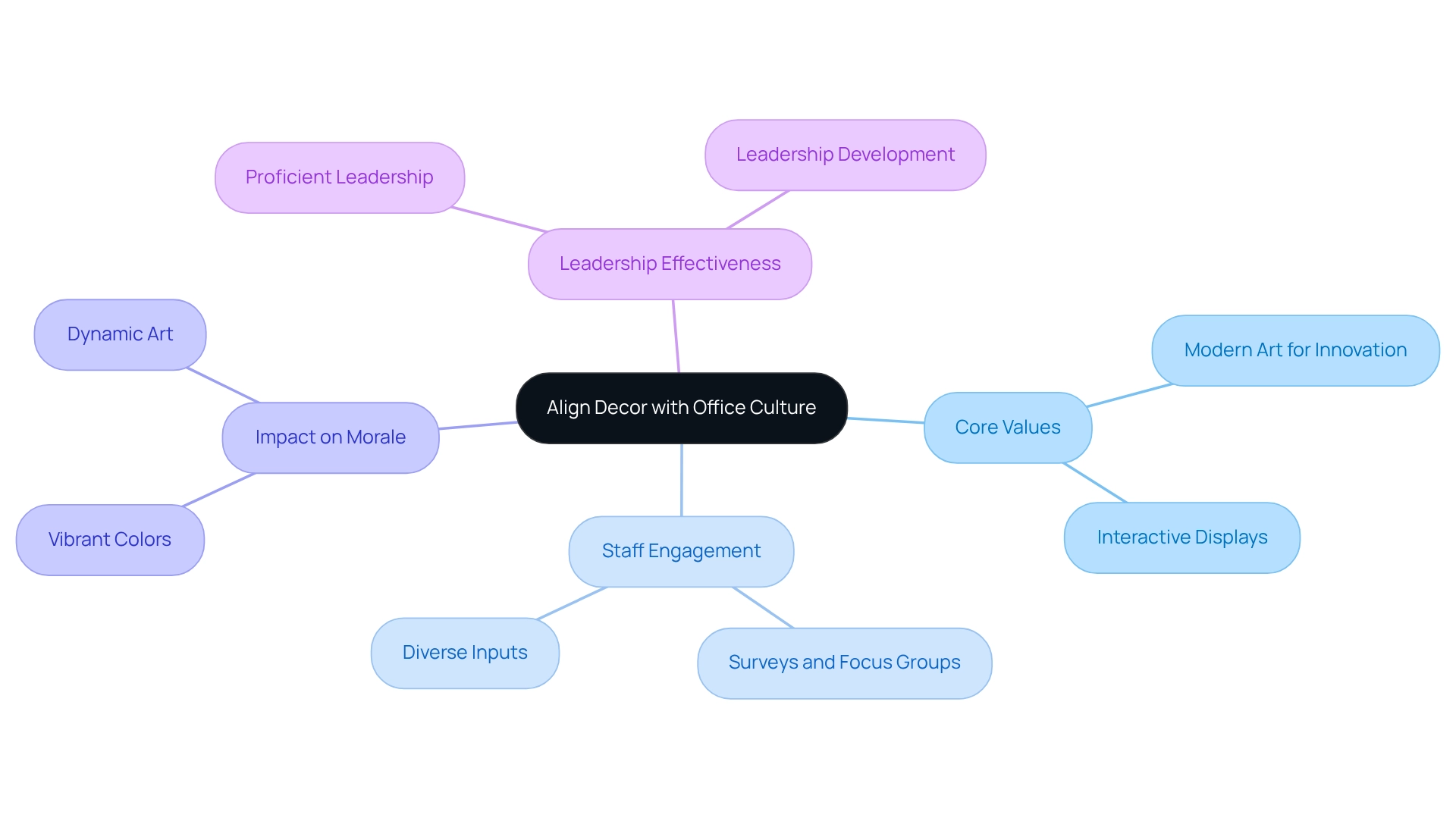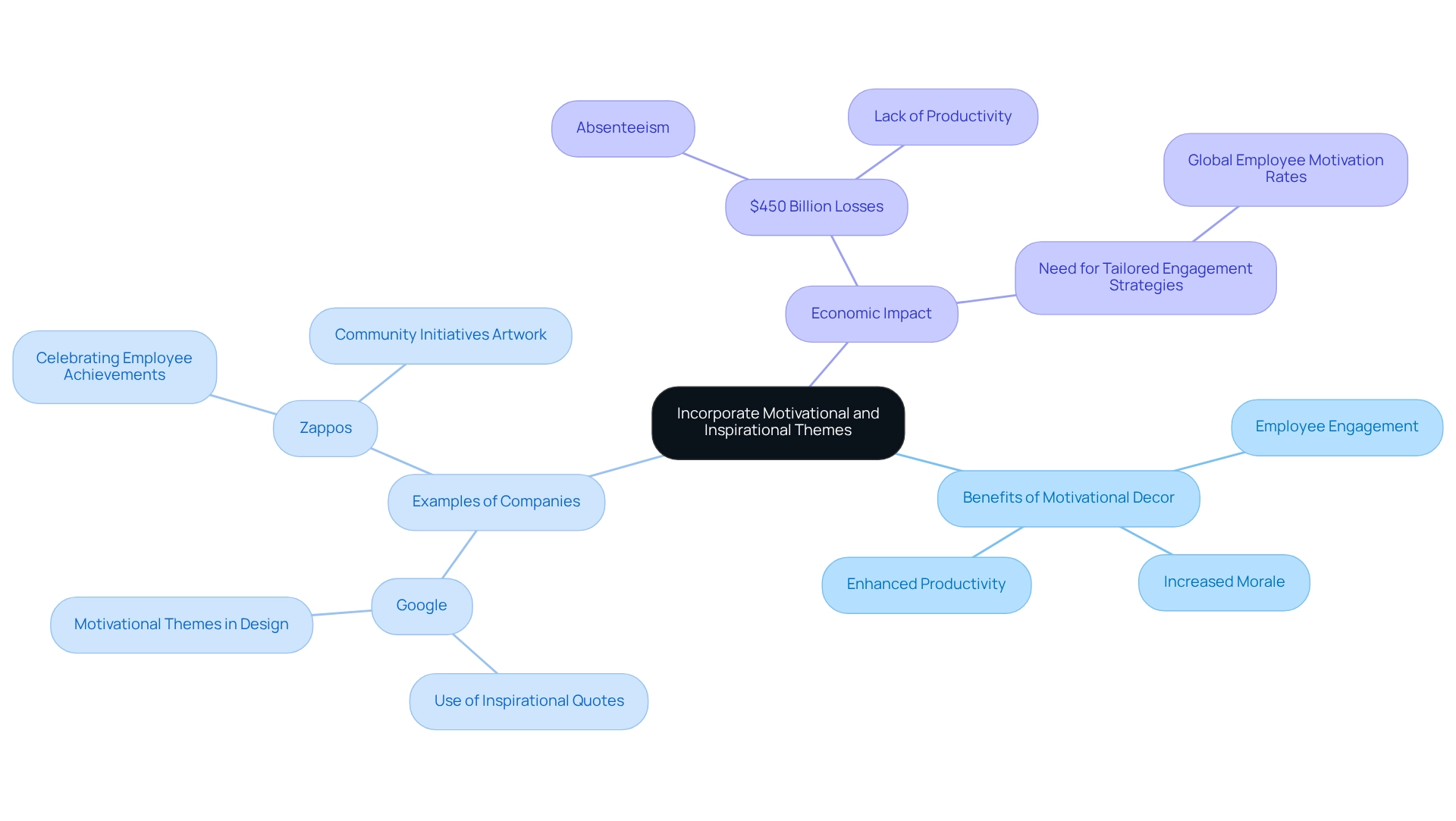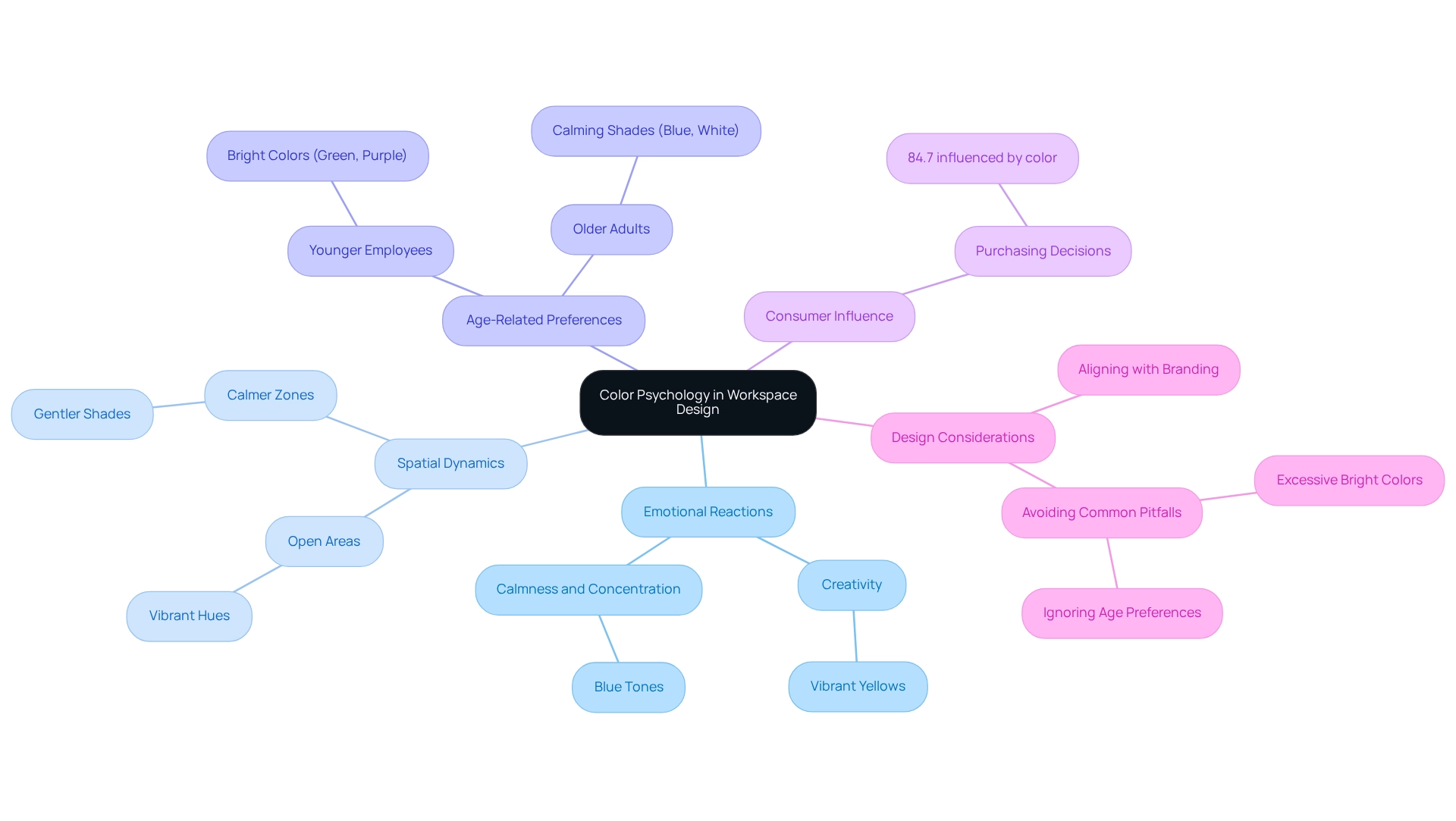Overview
This article explores four pivotal strategies for selecting effective office wall decor that not only aligns with organizational culture but also significantly enhances employee engagement. It underscores the necessity of:
- Aligning decor with company values
- Integrating motivational themes
- Leveraging color psychology
- Personalizing art selections
Collectively, these strategies cultivate a positive work environment and elevate morale, as evidenced by various statistics and examples from leading companies. By implementing these approaches, organizations can create spaces that resonate with their core values and inspire their workforce.
Introduction
Creating an inspiring and productive workplace transcends mere functional furniture and technology; it requires a deliberate approach to office decor that not only reflects but also enhances company culture. As organizations navigate the complexities of modern work environments, aligning decor with core values becomes essential in fostering employee engagement and satisfaction.
By incorporating motivational themes and color psychology, and emphasizing personalization through unique art pieces, the choices made in office design can profoundly influence morale and productivity.
This article explores strategies that businesses can implement to cultivate a vibrant workspace that resonates with employees and drives organizational success.
Align Decor with Office Culture and Environment
To effectively align office decor with your organization's culture, begin by evaluating the core values and mission of your business. For example, if innovation is paramount, consider integrating modern art pieces or interactive displays that inspire creativity. Engaging staff in the selection process is essential to ensure that the decor reflects their experiences and viewpoints. This can be accomplished through surveys or focus groups, allowing for a diverse range of inputs that embody the collective identity of the workplace. Notably, tech companies exemplify this approach by utilizing vibrant colors and dynamic art to promote a culture of innovation and collaboration, thereby enhancing staff morale and productivity.
Statistics reveal that 23% of leaders acknowledge being entirely ineffective in guiding virtual teams, underscoring the necessity for proficient leadership in cultivating a positive workplace culture, particularly in hybrid settings. Moreover, 72% of staff concur that engaged individuals think beyond their job title, highlighting the significance of involvement in the decor selection process. Organizations that prioritize leadership growth are more inclined to foster a positive workplace environment, making it crucial to align decor with company culture as part of a broader strategy for enhancing staff engagement and organizational performance.

Incorporate Motivational and Inspirational Themes
Incorporating motivational themes into office decor is a strategic move that can significantly enhance staff engagement and satisfaction. Displaying quotes from influential leaders or showcasing success stories from within the organization fosters a culture of inspiration and pride. For instance, dedicating a wall to employee achievements not only celebrates individual contributions but also motivates others to strive for excellence. Furthermore, artwork that mirrors the organization's mission or sector—such as visuals of successful projects or community initiatives—serves to enhance the workspace while strengthening the entity's core values.
Research indicates that motivational decor can lead to a more engaged workforce, which is crucial for a company's overall success. A staggering $450 billion in losses is attributed to unmotivated staff, highlighting the economic impact of absenteeism and lack of productivity. A survey of 10,000 workers revealed varying motivation levels across different nations, underscoring the need for tailored engagement strategies. Companies such as Google and Zappos exemplify the efficient application of motivational decor, having incorporated inspirational quotes and themes into their workplace designs. This approach has resulted in notable increases in employee morale and productivity, demonstrating the tangible benefits of a thoughtfully curated workspace. An engaged workforce is essential for a company's overall success, making the incorporation of motivational themes in workplace decor a strategic priority.

Utilize Color Psychology and Spatial Dynamics
Integrating hue psychology into workspace design is essential for selecting shades that elicit specific emotional reactions conducive to productivity. Blue tones, for instance, are renowned for fostering calmness and concentration, rendering them particularly suitable for conference rooms. Conversely, vibrant yellows can ignite creativity, making them ideal for collaborative spaces.
It is crucial to consider the spatial dynamics of the workspace; open areas thrive with vibrant, invigorating hues, while calmer zones benefit from gentler, more muted shades. Research consistently demonstrates that carefully selected hues can enhance employee satisfaction and productivity. Businesses that have adopted hue principles in their office designs report significant improvements in workplace morale and efficiency.
Notably, a study revealed that 84.7% of consumers are influenced by hue when making purchasing decisions, underscoring the profound impact that color can have on emotions and actions within a professional environment. Furthermore, understanding age-related hue preferences can refine these choices, as younger employees often gravitate towards bright tones like green and purple, whereas older adults may prefer calming shades such as blue and white.
Additionally, hues greatly influence how consumers perceive their emotions, which is pivotal in retail contexts. By leveraging hue psychology, businesses can design office wall decor that is not only visually appealing but also cultivates a positive and productive workplace atmosphere. It is equally important to align hue selections with contemporary branding strategies to ensure that office wall decor accurately reflects the company's identity.
However, caution should be exercised to avoid common pitfalls in applying color psychology, such as overwhelming spaces with excessive bright colors or overlooking the preferences of various age groups.

Emphasize Personalization and Unique Art Pieces
Incorporating unique art pieces that resonate with the interests and backgrounds of staff is essential for fostering a personalized workspace. This approach includes showcasing works by local artists or pieces that honor the organization's history and achievements. Establishing a rotating exhibition of staff artwork not only enhances the workspace but also fosters a sense of community and pride among team members.
A notable example is an organization that arranged an art contest, encouraging staff to present their designs, with the winning pieces prominently showcased in the office. This initiative enhances the aesthetic appeal of the workspace with office wall decor while strengthening team bonds and boosting overall workplace satisfaction.
Statistics reveal that 83% of staff consider artwork significant in their work atmosphere, influencing their perceptions of the organization. By prioritizing personalization in art selection, companies can significantly enhance workplace culture and employee morale, making art a strategic investment in organizational success.
Conclusion
Creating an inspiring workplace is essential for enhancing employee engagement and aligning with company culture. By assessing core values and involving employees in decor decisions, organizations can cultivate an environment that resonates with diverse perspectives.
Incorporating motivational themes and inspirational artwork not only boosts morale but also enhances productivity. Celebrating achievements through visual displays fosters pride and aspiration, while engaged employees significantly contribute to organizational success.
Utilizing color psychology is critical in shaping the workplace atmosphere. Thoughtfully chosen colors evoke emotional responses that enhance focus, creativity, and collaboration. Understanding age-related preferences and aligning colors with branding strategies can create visually appealing environments that promote productivity.
Personalization through unique art pieces enriches the workplace experience. Showcasing employee creativity and local artistry fosters a sense of community and belonging, making employees feel valued.
In conclusion, office design profoundly influences employee satisfaction and performance. By aligning decor with company culture, integrating motivational elements, leveraging color psychology, and prioritizing personalization, organizations can create vibrant workspaces that inspire and empower their teams. Investing in these strategies is crucial for fostering a thriving workplace that drives collective success.
Frequently Asked Questions
How can office decor be aligned with an organization's culture?
To align office decor with an organization's culture, evaluate the core values and mission of the business. For instance, if innovation is important, consider incorporating modern art pieces or interactive displays that inspire creativity.
Why is it important to engage staff in the decor selection process?
Engaging staff in the decor selection process ensures that the decor reflects their experiences and viewpoints, fostering a sense of ownership and connection to the workplace. This can be achieved through surveys or focus groups.
What are some examples of how tech companies align decor with their culture?
Tech companies often use vibrant colors and dynamic art in their office decor to promote a culture of innovation and collaboration, which can enhance staff morale and productivity.
What statistics highlight the importance of leadership in workplace culture?
Statistics show that 23% of leaders feel entirely ineffective in guiding virtual teams, emphasizing the need for proficient leadership to cultivate a positive workplace culture, especially in hybrid settings.
How does staff engagement relate to office decor and organizational performance?
About 72% of staff believe that engaged individuals think beyond their job title, indicating that involvement in the decor selection process can enhance staff engagement, which is crucial for improving organizational performance.
What is the broader strategy for enhancing staff engagement in relation to office decor?
Aligning office decor with company culture should be part of a broader strategy that prioritizes leadership growth and fosters a positive workplace environment to enhance staff engagement and organizational performance.



